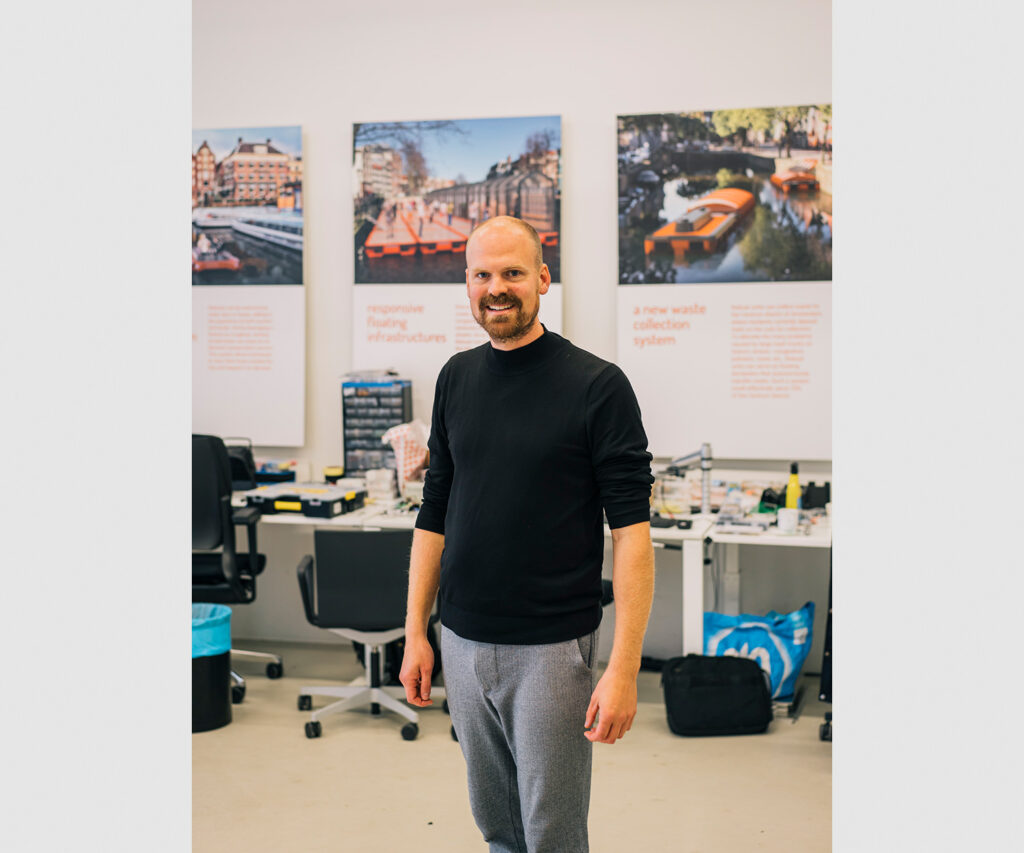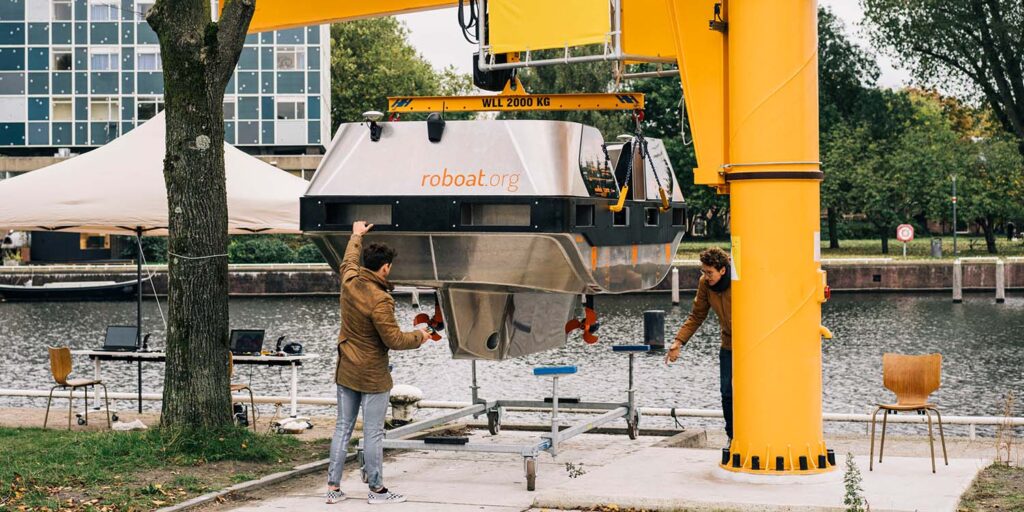The Amsterdam Institute for Advanced Metropolitan Solutions
Ynse Deinema smiles proudly. He grips a black waste bag firmly, walks to the quay and throws it into the black hatch of a compact metal boat moored at the test dock jetty next to the base of the AMS Institute in Amsterdam. The bag slides in and the hatch closes. The 34-year-old’s blue eyes light up: “Isn’t that great?” Ynse is the coordinator of the AMS’s Roboat project, an electrically propelled self-driving boat.
“You only have to tell it where it should go. It does all the rest itself,” says Ynse while watching the water where Roboat rotates in an almost elegant way, without producing emissions. He notes that today we are at the end of a five-year learning and testing phase in which his engineering team has developed Roboat . “Of course, I’m proud,” he says, “it was hard work, a team effort.”
Ynse studied neuroscience, holds a master’s degree in management and entrepreneurship, and says he’s always been “crazy about boats.” An avid boater, he discovered his love for robotics at Delft Technical University. While Roboat silently moves around the test dock with his “catch”, the waste bag, Ynse ‘s colleagues follow everything from the dock on a laptop.
In the open-air laboratory of the Amsterdam Institute for Advanced Metropolitan Solutions (AMS Institute), the Marineterrein Amsterdam Living Lab, researchers have successfully tested Roboat , a “robotic boat” at autonomous driving equipped with Torqeedo electric motors. This mobility revolution for the eco-friendly city of the future will include new ways of transporting people, goods and even waste. Very soon Roboat will be able to support the waste collection service and then transform cities all over the world.

The combination of electrical engineering and automation
Roboat is so advanced that the next phase of the project is already ready to begin: its commercialization. It seems that it’s only a matter of days before Roboat will join the members of the waste collection service in Amsterdam. Fleets for passenger transport are also planned.
Torqeedo sponsored the boat’s thrusters. “Here at Torqeedo we see huge potential. The combination of electrical engineering and automation offers enormous opportunities,” says Lukas Timcke, application Torqeedo engineer
Some legal issues need to be clarified before Roboat can travel along the canals of Amsterdam, but the AMS project coordinator is not worried: “We are working very closely with the Amsterdam authorities. The Netherlands is proactively dialoguing with researchers and companies about climate-friendly innovations for urban areas,” he explains.
To navigate autonomously and without collisions, Roboat uses sensors and cameras with a 360° field of view. This “discovery equipment” allows Roboat to learn and understand its surroundings. When it detects a new object, such as a canoe, the algorithm marks it as “unknown”. The team then analyzes the data, manually selects the object and names it a “canoe”. The algorithm is gradually being trained to be faster and more accurate even than the human eye.

The future of electric mobility on water
During the 20th century we saw a decrease in the use of Amsterdam’s canals for the transport of goods and people compared to the past. Nowadays it is mainly tourists who travel along the canals for pleasure. However, as urban centers around the world become increasingly populated, city officials are rediscovering the potential of waterways as a solution for relieving road congestion. Roboat ‘s goal is to revive this potential.
Anyone who thinks this is a distant future scenario needs to take a closer look at what is currently happening in Amsterdam. This city is a living lab of the future of electric mobility on water and was one of the first cities to pursue the “doughnut economy” model developed by British economist Kate Raworth. It is a model that defines the conditions for a sustainable economy in which the scope of economic activity is delimited by existing ecological and social boundaries and whose visualization resembles the shape of a donut.
“In the future, autonomous e-boats will be able to solve a lot of problems in modern cities,” says Alexander Oswald, Director of Application Engineering at Torqeedo. “There are numerous application areas. This emission-free, space-saving technology could lead to enormous cost and time savings. Goods deliveries, public transport, and data collection are potential applications.”

Marieke van Doorninck, the deputy mayor of Amsterdam, seems absolutely determined to make her city more livable and Roboat can play a decisive role in this. Combustion-fuelled refuse collection trucks cause traffic jams in the narrow streets of the Old Town, emit polluting exhaust fumes, and damage bridges and historic buildings along the canals. Amsterdam’s infrastructure dates back to the 17th century and was not designed to meet the challenges of a modern city with 800,000 inhabitants and more than 20 million tourists a year. Air quality also needs to be radically improved. The results of a study commissioned by the European Public Health Alliance (EPHA) published in 2020, undertaken by the renowned Dutch research and consultancy institute CE Delft, have shown that even small changes in the mobility habits of a metropolis can make a big difference.
Marieke van Doorninck , aims to institute both a circular, or donut, economy and self- sustainability. “The great thing about doughnut economics is that it offers a comprehensive framework in which ecological and social goals concur,”says Marieke . From 2030, only e-boats will be allowed on the canals of Amsterdam and by 2050 the city wants to become self-sufficient in terms of external resources.
Roboat research head and always involved in the AMS Institute, Carlo Ratti is an expert on the evolution that will shape the cities of the future and is the great thinker of the project. An architecture and engineering graduate, now a professor at the renowned Massachusetts Institute of Technology (MIT), he works as a designer and entrepreneur and commutes between New York, Singapore, Boston and Turin, providing his expertise on a focal point: sustainable urban concepts for the future.

Prototype for transporting people
“What we see here today is the outcome of a great deal of thinking. For five years, we carried out research, conducted trials, and built prototypes. It’s great to see that Roboat really works. It’s our baby,” says the 50-year-old Italian. In the future, Roboat will be able to transport not only waste or goods but also people, thus serving as a mini-ferry or water taxi.
“And that’s not all,” adds Carlo Ratti. “You can view Roboat as a floating pixel, as a dynamic element of urban architecture with which you can build a bridge or a floating stage. After all, several Roboats can be joined together via a lateral latching mechanism. If you include the waters of a city in your thinking, a new urban infrastructure emerges.”
Alongside Crystal 2, the Roboat for waste collection, we find Lucy 1, the prototype for transporting people, with enough space to accommodate up to five passengers. This is where the open-air test begins in the test basin. Roboat accelerates surprisingly quickly and maneuvers nimbly. The journey is as smooth as a short trip on the water, pleasant and relaxing.
Anyone who has attempted to maneuver a boat through Amsterdam’s narrow, busy canals know that it’s “careful as you go”. But Carlo doesn’t think the people of Amsterdam will be reluctant to share their canals with self-driving boats: “During the recent tests on autonomous cars in Singapore, we saw that people were open to this idea once they had the chance to try those things out themselves. So we’ve got to take people with us on our journey, so they get to know the technology. We’ve got to demonstrate the technology.”

Carlo points out that other cities such as Venice, Dubai and Stockholm are also interested in Roboat. More and more mayors have decided to meet or even exceed the EU’s energy and climate targets. Nearly 11,000 cities and towns in 53 nations have already signed up to the Global Covenant of Mayors for Climate & Energy and the number is growing. There is hope for our climate and for our cities and projects like Roboat show the way forward.


